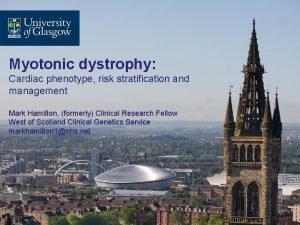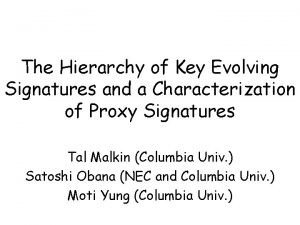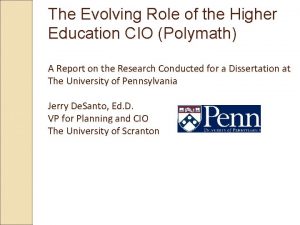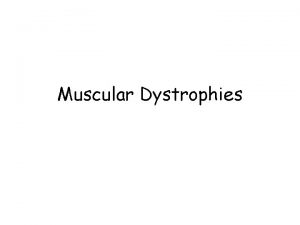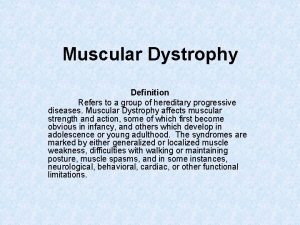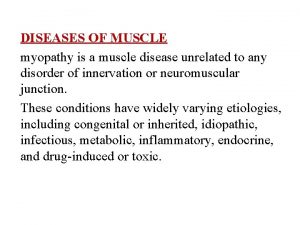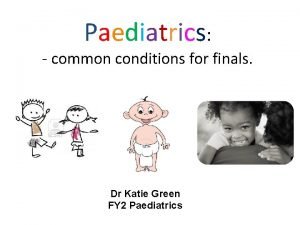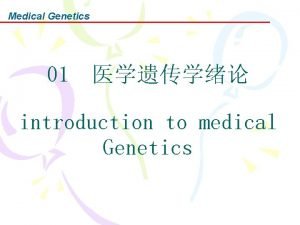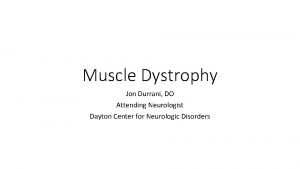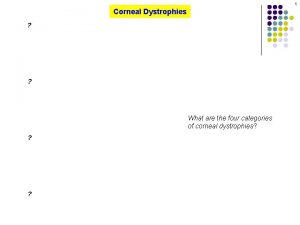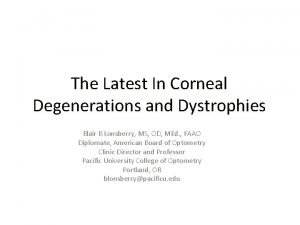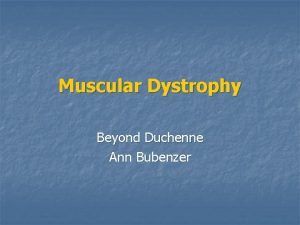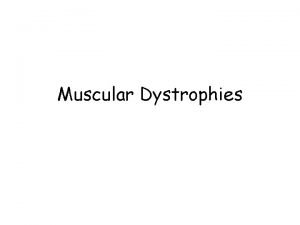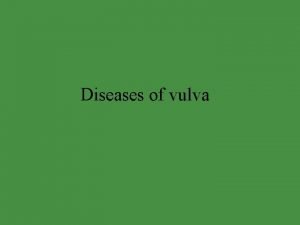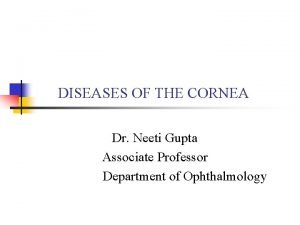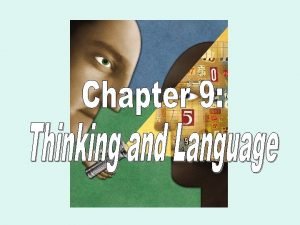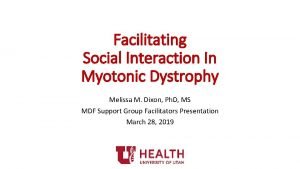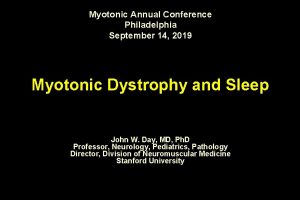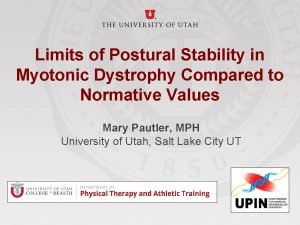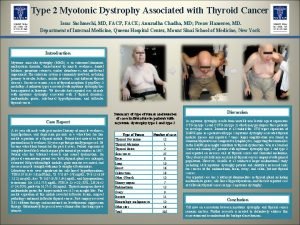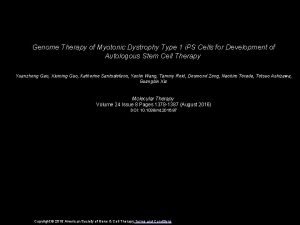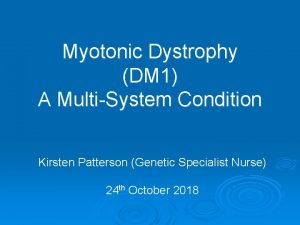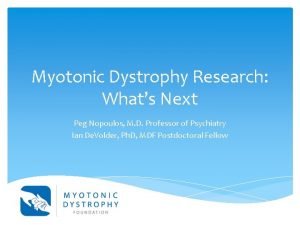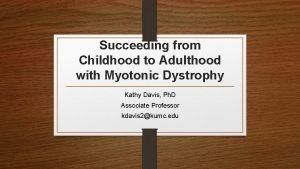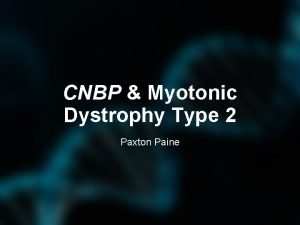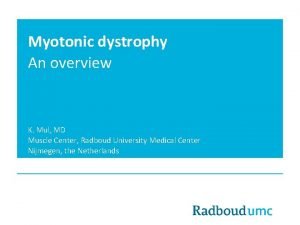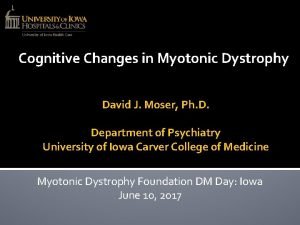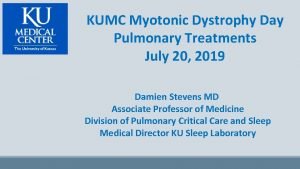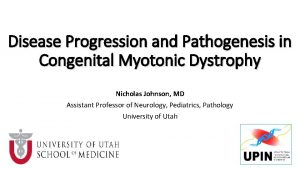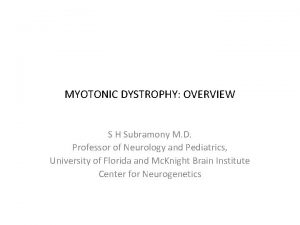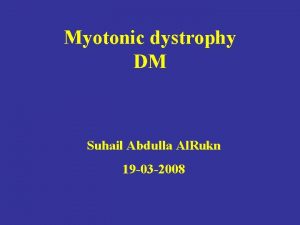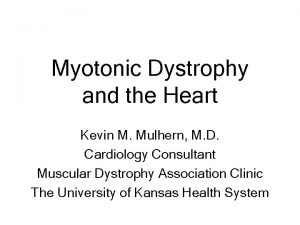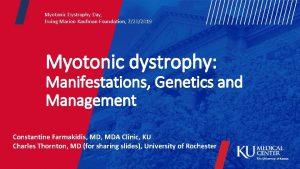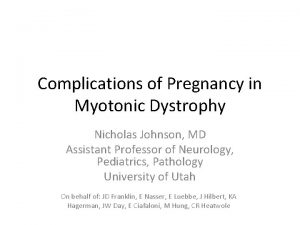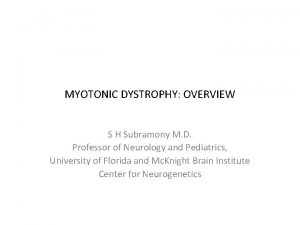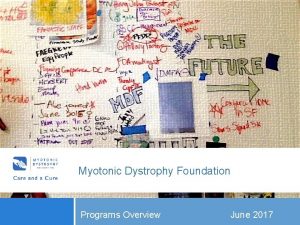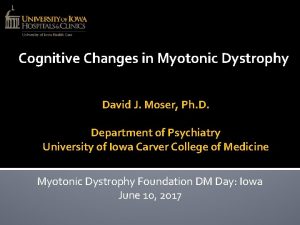Social cognition Evolving ideas in myotonic dystrophy John



























- Slides: 27

Social cognition: Evolving ideas in myotonic dystrophy John B Williamson, Ph. D University of Florida

Overview • Neuropsychology • Quality of life and social cognition • Understanding the effects of myotonic dystrophy on the brain • Brain and behavior • Linkage between the heart and the brain • Deficits in social cognition • How to understand address


Myotonic dystrophy affects the brain • DM is a multi system disorder • Heterogeneous • • GI dysfunction Cognitive and affective disorders Cardiac disease Endocrine abnormalities (e. g. , diabetes) • These conditions can influence one another • Effects can accumulate with age

Cognitive and emotional dysfunction and quality of life • • • Brain effects can be amongst the most debilitating Impacts how we understand relate to one another Independence Major National Institute of Health focus Cognition, depression, psychiatric problems, dealing with disease all negatively affect quality of life • Accumulates with age in MD 1, outcomes SF-36, neuropsych, and mood inventories (n = 40) • Antonini et al. 2006 • Positive for quality of life? • • Family interaction Exercise Self-efficacy Attention control

Cognitive impacts reported in DM • Lower abstract reasoning ability • Executive dysfunction • Visuospatial impairments • Social cognition • Verbal and non verbal memory • Basically all domains

Why the breadth? • Factors • Location of white matter disease • Asymmetries in brain atrophy and structural involvement • Duration of disease • Changes in emotional experience affect many patients • Changes in personality • And emotional regulation • Or Social cognition

Brain imaging in myotonic dystrophy type 1 • Okkersen et al. , 2017 – Neurology • Reviewed 81 studies • Changes widely dispersed • Generalized atrophy • Widespread gray matter volume reductions in all lobes, basal ganglia and cerebellum • White matter hyperintensity prevalence = 70% • DTI decreased FA in all major association, projection, and commissural white matter tracts. • Functional studies demonstrate reduced glucose uptake, cerebral perfusion in frontal, parietal and temporal lobes • Reduced functional connectivity • Longitudinal studies very rare

Most common deficits associated with white matter injury • Location matters, but commonalities • • • Fronto-subcortical dysfunction Processing speed Executive dysfunction Problems with word retrieval Apathy and abulia • Shown in Parkinson’s (Canu et al. , 2017)

Parent report • Parent-reported multi-national study of the impact of congenital and childhood onset myotonic dystrophy • N = 150 • 81. 7% = communication issues and fatigue, emotion issues also significantly elevated • Decreased performance in social situations had the highest average life impact scores. • Issues significantly associated with CTG repeat length • Paternal inheritance had greater representation of: • • Emotional issues Changes in body image Social issues Impaired sleep • Johnson et al. , 2017

What is social cognition? • is a sub-topic of social psychology that focuses on how people process, store, and apply information about other people and social situations. It focuses on the role that cognitive processes play in our social interactions

Social neuroscience, polyvagal theory • The autonomic nervous system “reacts” in a predictable hierarchical manner (dissolution). • The Polyvagal Theory uses evolution as an organizing principle to identify three neural ANS circuits, forming a phylogeneticallyordered response hierarchy, that regulate adaptation to safe, dangerous, and life threatening environments. • “Neuroception” of danger or safety or life threat trigger these adaptive neural circuits

Evolution and the ANS “new” vagus “old” vagus SNS

Dissolution • The higher nervous arrangements inhibit (or control) the lower, and thus, when the higher are suddenly rendered functionless, the lower rise in activity Cortex John Hughlings Jackson Subcortical Organs, e. g. , heart

Neuroception • The detection of features in others or the environment – without awareness – that dampens defensive systems and facilitates social behavior OR promotes defensive strategies of mobilization (fight/flight) or immobilization (shutdown, dissociation).

Feature Detectors: Safety, Danger, and Life Threat § The importance of face interactions, vocalizations, body posture, and gestures § Cues of safety or danger § Efficient strategy to co-regulate physiological state § Cues of safety promote co-regulation (intersubjective regulation)

Faulty Neuroception Challenges may: • Shift physiological and behavioral state • Distort social awareness • Displace ‘appropriate’ spontaneous social behaviors with asocial behavior or defensive reactions • Or, maintain social behaviors in an environment in which defensive strategies would be more adaptive

Neuroception Environment Behaviors Safe Social Engagement Danger Fight/Flight Life threat Shutdown Physiological State

Common disorders of social cognition • Autism • • Spectrum disorder GI problems Chronic stress Autonomic dysfunction • Patients with DM 1 often have • Reduced sensitivity to facial expressions • Particularly anger, fear and disgust • Associated with white matter injury • Kobayakawa et al. , 2010 • Also, higher rates of autism • Deficits in theory of mind

Heart rate variability declines with age and CTG repeat length • In DM 1 patients a decline in HRV is observed as the patient ages and CTG repeat length increases. • Hardin et al. , 2003 • Though heavily researched in other conditions, linkages between autonomic attributes and emotion have not been published in myotonic dystrophy • Could be relevant biomarker for some aspects of social function in MD 1 • Can be a sensitive intervention point

Autonomic features predict health outcomes • Resting HRV • High, low, very low, all associated with mortality • Low frequency HRV associated with coronary artery disease • Lower nighttime RSA associated with increased stroke risk • Binici et al. , 20

Theory of mind

Theory of mind and the brain • Many patients with DM 1 present with no cognitive impairment but still have severe difficulties in activities of daily living • Serra et al. , 2016 • 20 patients with DM 1 versus 18 healthy controls • Theory of mind tests • Reading the minds in the eyes • Relationship between CTG triplet expansion and severity of impairment • TOM story tests • Resting state f. MRI • Patients showed impairment in both tests • Associated with abnormal functional connectivity between temporal and frontocerebellar nodes • Shown to be important to theory of mind in other disorders • Schizophrenia, autism similar results



Potential non-pharmacological interventions • Psychotherapy • cognitive training targeting mentalizing abilities • Theory of mind training • Modulation of brain connectivity based on neurophysiological tools • Transcranial magnetic stimulation • Vagal nerve stimulation

Thank you! Funding support: - Department of Veterans Affairs - Mc. Knight Brain Foundation - National Institute of Aging - Center for Cognitive Aging and Memory - Brain Rehabilitation Research Center
 Myotonic dystrophy.
Myotonic dystrophy. Activator appliance
Activator appliance Jalan pintas mental
Jalan pintas mental Evolving design
Evolving design A framework for clustering evolving data streams
A framework for clustering evolving data streams Key evolving signature
Key evolving signature Evolving
Evolving Duchenne muscular dystrophy pedigree
Duchenne muscular dystrophy pedigree Duchenne muscular dystrophy
Duchenne muscular dystrophy Nursing diagnosis for muscular dystrophy
Nursing diagnosis for muscular dystrophy Goo1
Goo1 Signs of duchenne muscular dystrophy
Signs of duchenne muscular dystrophy Becker muscular dystrophy
Becker muscular dystrophy Dr katie green
Dr katie green Connate rachitis
Connate rachitis Which individual in the first generation is a carrier?
Which individual in the first generation is a carrier? Duchenne muscular dystrophy
Duchenne muscular dystrophy Marilyn monroe always gets her man in la county
Marilyn monroe always gets her man in la county Duchenne muscular dystrophy
Duchenne muscular dystrophy Mooren ulcer
Mooren ulcer Duchenne muscular dystrophy
Duchenne muscular dystrophy Emery dreifuss muscular dystrophy
Emery dreifuss muscular dystrophy Vulvar dystrophy thyroid
Vulvar dystrophy thyroid Dr neeti gupta
Dr neeti gupta Limb girdle muscular dystrophy
Limb girdle muscular dystrophy Cognition refers to
Cognition refers to Mse example
Mse example Cognition mse
Cognition mse
